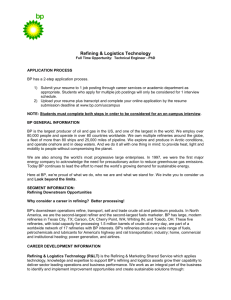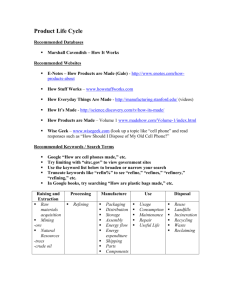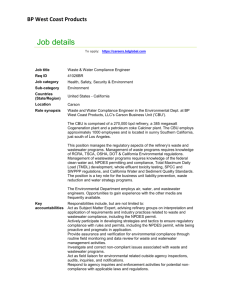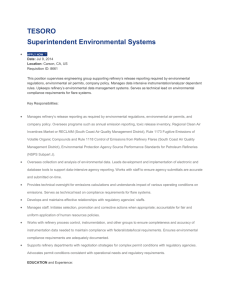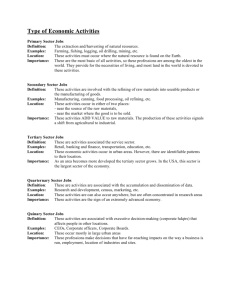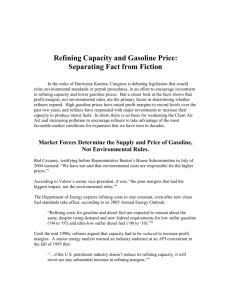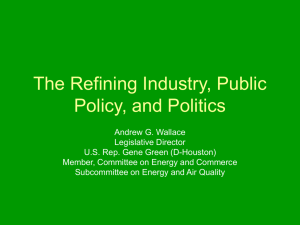Document 12820906
advertisement
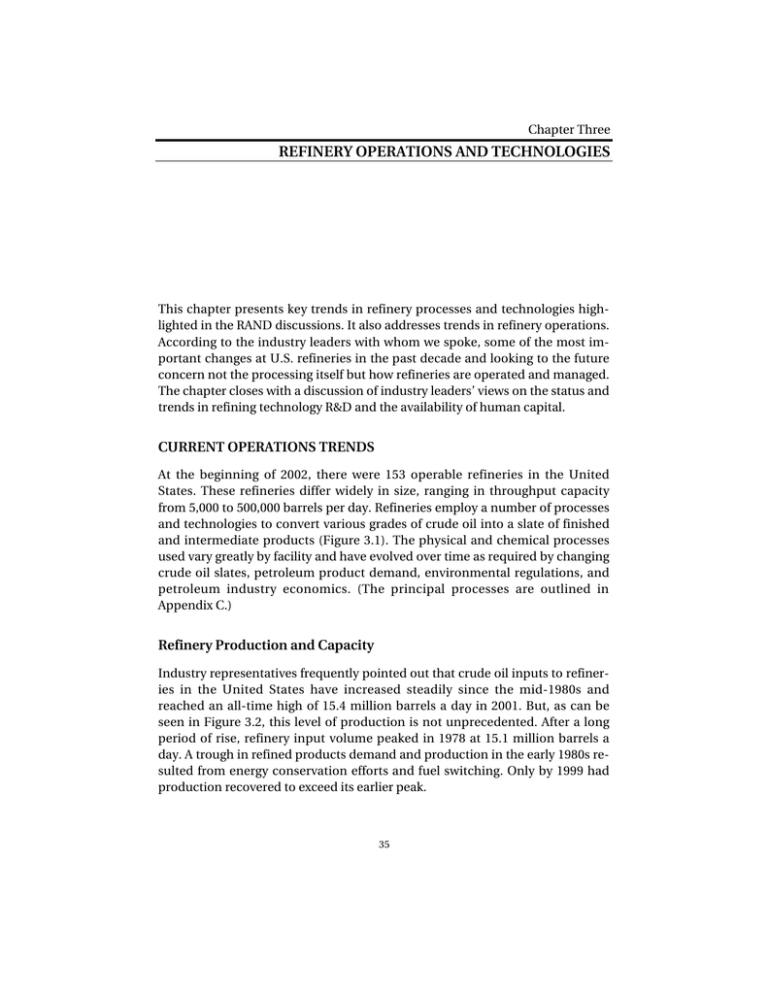
Chapter Three REFINERY OPERATIONS AND TECHNOLOGIES This chapter presents key trends in refinery processes and technologies high­ lighted in the RAND discussions. It also addresses trends in refinery operations. According to the industry leaders with whom we spoke, some of the most im­ portant changes at U.S. refineries in the past decade and looking to the future concern not the processing itself but how refineries are operated and managed. The chapter closes with a discussion of industry leaders’ views on the status and trends in refining technology R&D and the availability of human capital. CURRENT OPERATIONS TRENDS At the beginning of 2002, there were 153 operable refineries in the United States. These refineries differ widely in size, ranging in throughput capacity from 5,000 to 500,000 barrels per day. Refineries employ a number of processes and technologies to convert various grades of crude oil into a slate of finished and intermediate products (Figure 3.1). The physical and chemical processes used vary greatly by facility and have evolved over time as required by changing crude oil slates, petroleum product demand, environmental regulations, and petroleum industry economics. (The principal processes are outlined in Appendix C.) Refinery Production and Capacity Industry representatives frequently pointed out that crude oil inputs to refiner­ ies in the United States have increased steadily since the mid-1980s and reached an all-time high of 15.4 million barrels a day in 2001. But, as can be seen in Figure 3.2, this level of production is not unprecedented. After a long period of rise, refinery input volume peaked in 1978 at 15.1 million barrels a day. A trough in refined products demand and production in the early 1980s re­ sulted from energy conservation efforts and fuel switching. Only by 1999 had production recovered to exceed its earlier peak. 35 36 New Forces at Work in Refining RANDMR1707-3.1 LPG Crude distillation Light naphtha Gasoline Isomerization Naphtha Kerosene Distillate Crude oil Catalytic reforming Hydrotreat Gasoline/ petrochemical Hydrotreat Jet fuel/diesel/ heating oil Hydrotreat Diesel/ heating oil LPG/ petrochemicals Alkylation Polymerization Etherification Heavy gas oil Fluid catalytic cracking Gasoline Gasoline Hydrotreat Diesel/ heating oil Gasoline Hydrocracker Jet fuel/diesel/ heating oil Hydrotreat Coker Coke Diesel/ heating oil Asphalt/ heavy fuel Figure 3.1—Principal Refinery Processes and Outputs One of the critical measures of the U.S. refining industry’s ability to meet prod­ uct demand is crude distillation capacity. At the beginning of 2002, estimated capacity in the United States stood at 16.8 million barrels per day. Total U.S. re­ finery capacity increased steadily to meet growing demand in the post–World War II era (see Figure 3.2). Despite falling demand, between 1975 and 1981 the construction of small, simple refineries was further stimulated by federal crude oil supply controls, which gave unusual supply advantages to small refineries. A subsequent shake-out in the industry as a result of crude oil supply deregula­ tion led to a sharp decrease in available capacity (mostly topping units) before capacity leveled off in 1985. Capacity then dipped again in 1993–1994, as several refineries closed rather than revamp for reformulated gasoline production. In the mid-1990s, capacity growth resumed by an average of about 1.5 percent per year. A total capacity of about 1.4 million barrels per day was added between 1995 and 2001—equivalent to the output of three large refineries (EIA, 2003b). The increase in capacity occurred despite the sustained drop in the number of operable refineries since 1982 (Figure 3.3). Refinery Operations and Technologies 37 RANDMR1707-3.2 19 18 Million barrels per day 17 16 15 14 13 12 Available capacity Actual input 11 10 1970 1975 1980 1985 1990 1995 2000 SOURCE: Energy Information Administration (2002a, 2003c). Figure 3.2—U.S. Crude Distillation Capacity and Input at Operable Refineries, 1970–2002 100 330 95 310 90 290 85 Operable refineries (left axis) 270 80 250 75 230 70 210 65 190 60 Utilization rate (right axis) 170 150 1950 55 50 1960 1970 1980 1990 SOURCE: Energy Information Administration (2002a). Figure 3.3—U.S. Refineries and Capacity Utilization, 1950–2002 2000 Utilization rate (percent) Operable refineries RANDMR1707-3.3 350 38 New Forces at Work in Refining Surviving refineries have kept up with product demand in the United States through three mechanisms: • Strategic investments in new processing units to add capacity aimed at ex­ ploiting market opportunities • Low-cost incremental expansions (known as “capacity creep,” or “cheap creep”) in existing processing units through removing physical bottlenecks, applying advanced catalysts, and introducing other productivity enhance­ ments • More-intensive use of existing capacity by lengthening unit run times be­ tween repairs, required maintenance, and overhauls. Maintaining adequate capacity at existing refineries to meet market demand and maintain stable prices is critical because no one in the industry with whom RAND spoke envisions a new refinery being built in the United States given the range of hurdles faced by such projects in federal, state, and local permitting processes. Through expansions and upgrades at our refineries, we’ve increased our capacity by 150,000 barrels per day—the size of a world-scale refinery—at a cost of only $160 million. You couldn’t buy a refinery of similar size and complexity for anywhere near that price! —Refining company publication Looking forward, the Energy Information Administration projects demand to grow by 1.7 percent annually to 2025, slightly faster than the pace of growth in refinery capacity between 1995 and 2001. In contrast with conditions in the past, though, many refining executives with whom RAND met maintained that the industry had entered a new era and would be less likely in the future to keep up with demand through either strategic investments or capacity creep. They cited several trends for the change in conditions. First, many stressed that low or negative returns on investment in new capacity deter strategic investment. Available capital, they said, is being dedicated to up­ grading refinery processes to ensure products met new mandatory regulations, thereby crowding out investment to boost product quantity. Second, permitting constraints and stricter application of New Source Review rules in the 1990s, they said, deterred facility upgrades. Refinery Operations and Technologies 39 Yes, we can squeeze more capacity out of our existing refineries—perhaps 10 to 15 percent. This can be achieved by eliminating unnecessary failures and reducing the complexity of work processes followed by operations and maintenance personnel. There are still some improvements in reliability technologies that will provide higher production with current refinery configurations.... However, all of these are on the margin. —Technology and services executive Third, many discussants suggested that the era of low-cost capacity increases is nearing its end. Upgrading pipes, controls, catalysts, and boosting process tem­ peratures and pressures is no longer cost-effective without major changes in the capacity or configuration of reactor vessels—changes that are much more expensive. “Most of the easy, low-hanging-fruit investments have been made,” said one participant. Another concurred: “The capacity for additional im­ provements is declining.” Mid-size and smaller refineries could probably still obtain 10–15 percent increases, observed a third respondent, but larger firms “probably can’t go a whole heck of a lot higher.” Fourth, because of the physical properties of MTBE, its addition to reformu­ lated gasoline expanded the volume of the gasoline pool. The removal of MTBE and its replacement by ethanol will contract the volume of gasoline produced per barrel of oil refined—effectively reducing the output capacity of refineries. Finally, refineries in the past often invested in new throughput capacity in an effort to cover the costs of mandated (“non-return”) regulatory upgrades. “Environmental investment has stimulated capacity creep,” stated the repre­ sentative of one refining firm. Several executives pointed to the excess capacity and resulting slump in margins in the early 1990s caused by overbuilding as re­ fineries upgraded their facilities to comply with the reformulated gasoline re­ quirements that were coming into force. Some executives, however, claimed that the technological feasibility and economic benefits of capacity increases as refiners revamp to comply with on-road ultra-low-sulfur diesel (ULSD) specifi­ cations in 2006 are more limited than those associated with implementation of reformulated gasoline and low-sulfur diesel fuel in 1994 and ultra-low-sulfur gasoline in 2004. After many years of steady increase, consumption of refined petroleum prod­ ucts in the United States peaked in 2000–2002 with the slowdown in the U.S. economy. Projections by the EIA indicate that demand growth will resume with economic recovery—a view supported by many discussants. Add to this 40 New Forces at Work in Refining scenario discussants’ arguments that refinery capacity growth and product imports are constrained, and it is likely the United States will experience signifi­ cant supply disruptions and price pressures in the future. One executive as­ serted, “We are going to get price disruptions.” Is there room for improvement? Absolutely. We have made tremendous improvements and we still see gaps that can be closed. You show me a refinery that can’t be im­ proved.... We have found ways to creep capacity with fairly minimal investment, but there has to be a limit to that. —Refining executive On the other hand, other discussants suggested that the conditions and deci­ sionmaking drivers in the past were still operational in the current era. One supplier representative maintained that “creative methods” to renovate facili­ ties for ULSD production, including capacity expansions, were available to help lower the cost of compliance below those projected by a number of studies.1 An executive of a smaller refiner agreed with this view. Another small-business re­ finer executive pointed out that his firm was increasing the capacity at two of its refineries by over 10 percent—16,000 barrels per day—while complying with cleaner fuels requirements. An executive of a mid-size refiner stated that his firm was going to increase capacity with the transition to ULSD as a way to jus­ tify the cost, and he predicted a “tremendous expansion” at other firms. Limit­ ing production to high-sulfur products was not viable over the long term, some speakers pointed out, because this would quickly lead to falling prices in what are small market segments. In sum, many discussants doubted whether indus­ try executives really would change their behavior and, acting independently in a competitive market, would forgo market opportunities. Several asserted that significant cost-effective capacity increases, by them­ selves, could yet be obtained. “There are a lot of smart people and they can fig­ ure that out. I would never say we have reached the top.” A technology supplier said: “We are very successful at finding new life in dinosaurs.” Another services supplier said, “There is quite a bit of benefit to be extracted.” Idled capacity can be brought back on-line, noted a discussant.2 Three executives noted that the recent wave of mergers had created new opportunities to “ration­ alize” operations and share know-how and best practices. “We think there are tremendous synergies to be realized” by operating larger refinery net­ ______________ 1A number of studies of the cost and supply implications of ULSD implementation are summarized in EIA, 2001. 2Capacity at idled refineries amounted to 539,000 barrels per day in January 2002 or 3.3 percent of total operating capacity (EIA, 2002b). Refinery Operations and Technologies 41 Industry leaders debated whether refinery capacity in the future could be substantially increased without increasing the size of pipes and vessels—changes that entail significantly larger capital expenditures and more-complex permitting requirements. works, said one. Indeed, a discussant stated that productivity enhancements derived from consolidated operations would further drive down refining mar­ gins over the long term. There looks like there is oversupply in just about every region and just about every product. Small refiners can’t drop off fast enough to counter the big guys’ improve­ ments in efficiency. —Technology and services executive Such expectations of continued expansion in refinery capacity are in line with data and projections produced by the Energy Information Administration (2002a, 2003b). As can be seen in Figures 3.2 and 3.3, the downstream has been expanding capacity at a fairly robust rate since 1996, despite continued facility closures. This expansion is likely a result of decisionmakers’ response to improved returns and new market opportunities. Looking to the future, the EIA’s reference base case shows refinery crude oil distillation capacity increasing from 16.8 million barrels per day in 2001 to an estimated 19.8 million barrels per day in 2025, or 0.7 percent annually. In this business-as-usual case, domestic refining does not keep up with the 1.7 percent annual projected 42 New Forces at Work in Refining increase in petroleum consumption. Because decisionmakers with whom RAND spoke did not see a significant increase in product imports, they generally thought refiners would have to significantly increase the pace of net additions to domestic capacity over that of recent years to meet the increase in demand projected by the EIA. Refinery Utilization As noted above, U.S. refineries have been able to keep up with growing product demand through the more-intensive utilization of available capacity. After staying above 90 percent in much of the 1950s and late 1960s and early 1970s, capacity utilization on an annualized basis dipped below 70 percent in the late 1970s, as a result of excess investments in capacity, economic recession, and energy conservation efforts. In the 1980s and 1990s, utilization rates gradually recovered as the number of operating refineries declined, companies tried to restrain their capacity increases, and energy consumption grew. In 1998, capac­ ity utilization reached a 50-year high of 95.6 percent before easing in subse­ quent years (see Figure 3.3). The trend toward higher utilization in recent years has also been enabled by operations changes: reducing refinery downtime by increasing hardware reli­ ability and reducing the number of unplanned outages; executing maintenance and revamps more efficiently; and extending run times by means of enhanced catalyst performance (see Chapter Four). According to one discussant, another driver is better market information and transparency. With greater information about the status of a firm’s supply chain and inventories, maintaining just-intime operations and running on the edge have become less risky from a busi­ ness perspective. The market does not pay for spare refining capacity. Why would anyone invest? —Refining executive For many of the industry executives with whom we spoke, a high rate of utiliza­ tion as viewed by corporate leaders, is a sign of good asset management. Many also suggested it signaled a shift in the mindset of industry managers: As noted in the previous chapter, discussants cited a new, more discriminating approach to investment and supplying the market that emphasized maximizing margins and returns on investment rather than product output or market share. The ex­ cess capacity that dogged the industry for 20 years is now gone, and profits and returns on investment have improved. Refinery Operations and Technologies 43 Others worried that the industry was reaching its technical limits. Pushing too far could invite malfunctions and product shortages—as has been the case in California and the Midwest. The maximum sustainable utilization level was 96 percent, said one executive. Said another refiner representative, “Ninety-six percent is the absolute maximum, 94 percent is really pushing it.”3 Industry representatives and others have been particularly outspoken in public forums about the potential for supply disruptions resulting from a lack of spare capac­ ity (e.g., Slaughter, 2002; National Petroleum Council, 2000). For individual companies, however, this condition is desirable. “High utilization is a signal of the good use of assets,” said one refining executive. Nevertheless, the tight supply conditions of the late 1990s have eased and are unlikely to return in the short term. Industry-wide utilization rates fell back to the 92–94 percent range in 1999–2002—a result of softening demand because of the economic slowdown, continuing increases in available capacity, and several poorly executed turnarounds (periodic maintenance overhauls) (EIA, 2002a and 2003c). CURRENT TRENDS IN TECHNOLOGIES The petroleum refining industry relies on mature technologies and processes— many of which were developed decades ago. The increases in productivity ex­ perienced in the 1990s were achieved through incremental improvements in existing refinery equipment, processes, and practices. “Not much is being done on the processes themselves,” said one executive of a leading operating com­ pany. Below, we outline several of the more important incremental innovations over the past decade noted by the RAND industry participants: catalysts, in­ strumentation and controls, and maintenance and reliability technologies. In short, the pace of innovation in the downstream sector is being supported by applying technologies and know-how often developed in other sectors to im­ prove legacy refining processes. Catalysts Catalyst design and application were the areas cited by most discussants—operating company representatives, technology suppliers, and academics alike— as the most innovative and useful technological developments in refining. Cata­ lyst technologies were once thought to have reached the limits of their potential development, yet the 1990s saw a surge in innovation, often generated by inde­ ______________ 3For reference, the Energy Information Agency (2003b) has estimated business-as-usual utilization rates of 94.6–94.7 percent in 2015–2025. 44 New Forces at Work in Refining pendent third parties. Innovations occurred in catalyst materials, substrate materials and structures, and catalysis modeling and application. These inno­ vations have allowed refiners to vastly improve environmental performance, product quality and volume, feedstock flexibility, and energy management without fundamentally changing fixed capital stocks. Thanks to advanced de­ sign and manufacturing techniques, catalysts can now be formulated and manufactured for specific processing units, feedstocks, operating environ­ ments, and finished product slates—a capability described as “extreme cus­ tomization.” More recently, productivity improvements have also been achieved by realizing synergies among different types of catalysts. One execu­ tive at a major refinery reported that he was “fairly amazed” by the capabilities of catalyst suppliers. In addition to their improved performance, advanced catalysts are attractive to refiners because they offer a means to boost output and productivity using ex­ isting hardware. Several discussants, however, felt that the characterization of new catalysts as “plug-and-play” solutions for particular refinery unit opera­ tions was too facile. Many advanced catalysts are themselves costly and require infrastructure upgrades. One technology and services provider pointed out that catalyst and reactor design had to go hand-in-hand. In any case, the technology and services providers felt that catalyst development would remain far ahead of process development (at least until 2010, according to one technology execu­ tive) because reactor design, as understood today, was much more mature. “That’s where the action is,” said one engineering, planning, and construction company executive, referring to catalysis. “I think we are on the verge of a new edge here,” claimed a technology supplier. Catalyst technologies have moved a huge amount. We are at a point now that catalyst technology is so advanced and so pinpointed. —Refining executive Instrumentation and Controls Innovations in advanced process monitoring and controls have allowed refiner­ ies not only to operate more efficiently and safely but also to produce fuels to more-exacting product quality specifications in a more reliable manner—not unlike a highly automated chemical plant. Reducing their “performance win­ dow” and boosting quality assurance has enabled refinery operators to produce cleaner and higher-performance fuels. Refinery Operations and Technologies 45 Several significant changes have occurred to drive process optimization to new levels: • The development of advanced and reliable instrumentation that senses product chemistry, as well as temperature and pressure, has increased the volume, precision, and frequency of information generated about process status in specific unit operations. • Ubiquitous communications networks have increased information flows and knowledge management (that is, the use of the information generated). This has driven facility-wide process integration. Refinery operators can better predict process dynamics by using advanced operations modeling— made possible in part through cheaper and more powerful computing power and software. • Advanced process controls have enabled refinery managers to act upon this increased knowledge and more finely and reliably manage unit operations. Although one discussant said that most of the productivity gains from better in­ strumentation had been achieved during the 1990s, there still were benefits to be gained from better knowledge management—for instance, using data that are being generated in the plant for benchmarking performance and to test and optimize process models and control algorithms. “You can do a lot more with the information that is in the plant.” Another operating company executive claimed his personnel were “overwhelmed by data” and that it was difficult to discern what information was important. He hoped that emerging technologies that employ artificial intelligence would help alleviate the situation. Discussants cited several other promising technologies, such as more robust and sensitive chemical sensors—for example, to detect near-zero sulfur levels and discrete sulfur species. Non-destructive [inspection] techniques have improved to the point that we can see problems better from the outside instead of putting a person inside of the equipment. —Technology and services executive Maintenance and Reliability Maintenance protocols in the refining industry have traditionally been based on standard rules of thumb rather than on the performance of individual pieces of equipment. This resulted in “some units being overinspected or underin­ spected,” according to one technology and services executive. Moreover, a refinery’s maintenance and repair operations were evaluated according to how 46 New Forces at Work in Refining quickly a problem was fixed (described as “crash and dash”) rather than how much breakdowns and repairs cost. Eighty percent of [malfunction] risk is tied up in about 10–20 percent of the equip­ ment.... You use technology to think better.... We can see what kind of risk we are operating with today and drive it down. —Technologies and services supplier Today, refiners are adopting the more stringent and efficient maintenance regimes common in the chemical, nuclear, and aerospace industries to realize greater utilization rates and cost savings. Plant operators are increasingly able to monitor and address problems before breakdowns occur. This is due in part to the increased volume, accuracy, and accessibility of information about equipment status and trends. Vibration monitors, for instance, sense in real time the performance of pump bearings. X-ray imagery and mass spectroscopy are being used to inspect and monitor vessel and pipe wear, thereby reducing the need to open up equipment and place workers in hazardous environments. Maintenance and reliability efforts also are being targeted according to the like­ lihood of failure of specific pieces of equipment such as pumps and valves, based on statistical analyses of operating histories of similar components, tabu­ lated in extensive databases that are mostly proprietary. More recently, risk analysis tools and management practices are being applied to whole classes of equipment on a refinery-wide scale to target “mission critical” units, the failure of which can have costly refinery-wide implications. Looking to the future, dis­ cussants noted that improved equipment performance models and algorithms would enable operators to reliably predict materials corrosion rates. The value of performance-based maintenance and risk management lies in in­ telligent scheduling of operations to minimize “preventable maintenance” and other unnecessary work while avoiding discrete failures that can disrupt an en­ tire process unit. “Any time you open something, you run the risk of inducing failure with something else,” observed one discussant. Longer run times mean plant equipment is cycled up and down less frequently: “It’s taking [the plant] up and putting it down that hurts it the most,” said another discussant. As in other industries, maintenance and reliability have gained much greater prominence in the refining industry, not only as a tool to improve productivity but as a key element of corporate environment, health, and safety policies and business risk-management strategies. Major breakdowns arouse concern among neighbors, invite scrutiny from government officials, and generate bad publicity among the general public. Said one refining executive: “We never want to be the low-cost maintainer of facilities.” As the industry moves toward Refinery Operations and Technologies 47 the higher-temperature and higher-pressure processes required for deep desulfurization, systems, reliability will become more important. Yet significant variation in practices remains within the industry. Some com­ panies, said one services provider, “have made smart choices about what causes failure and have put in place smart practices and people.” Other refiner­ ies, he added, are “just horrible.” One executive noted that experience with performance algorithms was “not that positive” and that models needed to be more accurate and generate fewer false alarms. For another, the challenge lies in improving knowledge management: Often, red flags are not heeded by plant operators. One cause of this problem is culture. Line operators receiving the information do not feel authorized or do not have the proper incentives to make critical operational decisions. “We need to better understand how to use today’s technologies more effectively,” said one executive. Variation in mainte­ nance and reliability in the industry is partly a function of industry maturation and restructuring. It was argued that the number of refinery owners and man­ agers who take greater business risks and have little interest in maintenance (characterized by the “run ’til it breaks” mentality) is quickly diminishing—superseded or bought out by larger players with more standardized and stringent maintenance protocols. LONGER-TERM TRENDS IN TECHNOLOGIES AND OPERATIONS Refinery Processes None of the refining industry leaders with whom we spoke predicted funda­ mental refining process technology innovations in the foreseeable future. There are “no revolutionary new processes out there,” said one discussant. This per­ spective is not surprising. Refining executives, like those in many other sectors, focus on the short term—a situation intensified by the industry’s recent eco­ nomic hardships and volatility, corporate retrenchment, mergers and acqui­ sitions, and preoccupation with regulatory compliance. Unlike such newer sectors as biotechnology and information technologies, innovation in mature­ process industries tends to be more incremental. And, as in other industries with an extensive and expensive fixed capital base, operating companies have little incentive to promote fundamentally new technologies that might result in the accelerated depreciation or scrapping of a substantial part of their existing capital stock. Nonetheless, several potentially significant technological developments were mentioned during the RAND discussions. Several advances in oxidative, bio­ catalytic, adsorption, and membrane technologies are in the development and demonstration phase. Given the need for “deep desulfurization,” these tech­ nologies could reduce the hydroprocessing required for gasoline and diesel 48 New Forces at Work in Refining desulfurization, and they are expected to greatly facilitate ultra-low-sulfur fuel production and finishing by allowing operation at lower temperatures and pressures. The economic benefits could be significant because capital and op­ erating costs for hydroprocessing units and dedicated hydrogen production are substantial. Discussants also pointed to other technologies on the horizon, such as “flooded tower” or liquid continuous distillation technologies. Finally, on two occasions, technology suppliers alluded to significant innovations in basic refinery processes on the horizon, but they declined to describe them. We are focused on little R and big D. Our horizon tends to be in the two- to five-year time frame. We are very driven by the near term. Once you get beyond five years, the market gets very difficult to predict. —Technology and services executive Such innovations are being made possible by advanced process monitoring and measurement technologies and process modeling and simulation capabilities— all enabled by the rise of inexpensive and robust computing power and im­ proved understanding and control of unit operations. Better measurement, it was asserted by one technology developer, will continue to drive the discovery process: “We are just beginning to get the tools to understand what’s going on. There is still room to learn in there.” [Company] has made a breakthrough in the cost-effective removal of sulfur from oil. This will lead to economical desulfurization plants at crude oil production sites, as well as low-cost polishing units to desulfurize refined products, such as diesel fuel, to very low sulfur levels at a fraction of the cost of conventional technologies. —Technology supplier company publication In contrast to the absence of fundamental refining process innovations, refining executives did identify several long-term trends that could affect the process mix and the slate of products of the refinery of the future. One issue that has been contemplated for many years is the integration of refinery operations with petrochemicals production. Other more recent issues under consideration con­ cern electricity and hydrogen production and fuel cell vehicles. Cogeneration Refining is the largest industrial consumer of energy in the United States. Re­ fineries, in turn, produce substantial volumes of steam and combustible by­ Refinery Operations and Technologies 49 products that can be devoted to commercial (merchant) power generation. “We are the natural partner for an independent power producer,” claimed one exec­ utive. Several trends in refinery operations were cited as facilitating commercial electricity production. One driver is the desire to cut energy costs through heat integration. Second is the increasing need to utilize petroleum coke, a refinery by-product that is being produced in greater quantities as the nation’s crude slate becomes heavier. Improvements in coke gasification technologies, com­ bined with the declining value of coke on export markets, are making this a more attractive match with cogeneration. “We are huge producers of petroleum coke. We have to find new markets,” said one refining executive. Finally, elec­ tricity generation is also seen as an attractive alternative to flaring off by­ product fuel gas which is subject to Clean Air Act rules and considered a visual nuisance (“to keep the phone from ringing,” said one discussant). The future refinery will be an energy provider. The technologies exist today, it’s just a matter of money. —Refining executive Many discussants were not convinced that there would be a widespread move­ ment toward power production in the refining industry because of fundamental technical, regulatory, and business obstacles. Several reasons were cited: • The ability to sell power to the merchant market is determined by the regu­ latory and business environment in each state and local jurisdiction. Deregulation and the drive to develop merchant power production capacity were blunted when problems emerged in California in 2000 and 2001 after the state deregulated the power industry. • The managerial and operational philosophies in the refining and electric power industries are quite different and potentially incompatible. Utility operators require highly reliable, on-demand electricity supplies that do not necessarily match refinery operation schedules or priorities. • Only a limited number of refineries are favorably positioned by their con­ figuration to cost-effectively generate electricity on a large scale. Most in­ vestments to date have been small entrepreneurial ventures—on the order of millions of dollars invested, said one technology supplier executive. • Some refiners who were interested in pursuing cogeneration options and forming “energy-type” companies found themselves capital-constrained. • Environmental regulations tended to limit projects to those that could be implemented “under the permitting radar.” 50 New Forces at Work in Refining • Petroleum coke gasification requires economy of scale. One discussant noted that for many refineries, this can only be achieved through joint ventures that entail coordination of operations and financing, significantly increasing organizational challenges. In the 1990s, many refineries were considering joint ventures with utilities. In­ terest has now cooled—because of the reasons cited above and a temporary slackening of demand for electricity and volatility in the utility sector. These problems notwithstanding, most discussants agreed that there would probably be a discernible movement toward commercial power production by refineries after the demand for electricity revives and the hurdles of gasoline and diesel desulfurization are cleared in 2006. Hydrogen Production Hydrogen is an essential input in many refinery operations, such as hydrotreat­ ing, hydrocracking, dearomatization, and isomerization.4 Hydrogen demand at refineries is expected to increase significantly in the coming years for use in hy­ drotreaters to produce ultra-low-sulfur gasoline and diesel fuel. Much of the hydrogen supply at refineries is a by-product of other refinery processes (catalytic reforming) and is supplemented with dedicated hydrogen production units, such as steam methane reformers. Hydrogen can also be produced at the refinery from heavier fossil fuels and hydrocarbon waste through petroleum coke gasification. (See Appendix C for a full discussion of these processes.) Over the longer term, say 10–20 years, some futurists (e.g., Hoffmann, 2001; Rifkin, 2002) have predicted the advent of a “hydrogen economy” associated with the advent of fuel cells for stationary power generation and for transporta­ tion. In early 2003, the Bush administration announced a new DOE program to develop a vehicle to realize this goal. Many discussants asserted that since petroleum refineries are already positioned to produce hydrogen, they have an important role to play in a potential hydrogen economy. However, demand projections for hydrogen as a transportation fuel were seen as highly specula­ tive and not within the investment horizon of the refiners with whom we spoke. Some discussants felt that the widespread use of steam methane reforming, a well-established technology, to produce and sell excess hydrogen for the mar­ ket did not make economic sense unless promoted with significant subsidies or fuel tax advantages. Gasification of heavy refinery residues, coal, and waste was seen as promising, but the required technologies were seen as still not robust or ______________ 4 For more detailed discussion of these processes and the use and production of hydrogen in refining, see Appendix C. Refinery Operations and Technologies 51 cost-effective enough to warrant investment in production. Moreover, since these technologies involve the consumption of fossil fuels, the environmental benefits of manufacturing hydrogen fuel in this manner would not be favorable, unless the entire supply chain resulted in a net reduction in carbon emissions. Liquid Fuels for Fuel Cell Vehicles As noted in Chapter Three, refining industry leaders with whom we spoke unanimously believed that the energy source of choice for fuel-cell vehicles should be petroleum-based liquid fuels—at least for a substantial period of transition until the economic and technological hurdles associated with hydro­ gen were overcome. The criteria for a high-quality liquid fuel for a fuel-cell vehicle would be quite different from those for a vehicle with an internal combustion engine. For ex­ ample, high octane—a favorable characteristic of gasoline when burned in an internal combustion engine—would not impart any advantages when con­ sumed in a fuel-cell reformer. Such fuels, several discussants noted, preferably would be light, straight-chain hydrocarbons, which have a higher ratio of hy­ drogen to carbon than aromatic hydrocarbons or olefins. Also, low concentra­ tions of aromatics, napthalenes, detergents, and sulfur are needed to avoid de­ grading fuel processor efficiency, since these substances can poison catalytic sites and inhibit reforming. In particular, sulfur would need to be reduced down to near-zero levels to preserve the life of the fuel cell catalyst. This would be oc­ curring at the same time as the world’s crude supply becomes more carbon­ and sulfur-rich, making the challenges of manufacturing ultra-clean fuels (and disposing of the by-product residues) more complex. Thus, existing refinery capacity would have to be substantially revamped to manufacture the ideal fuel-cell fuel. Refinery executives did not speak at length about implementation issues surrounding various transition fuels because pro­ duction of those fuels was not within their business horizon. THE ENVIRONMENT FOR TECHNOLOGY INNOVATION Increasing demand for fuels, potential technological constraints on increasing refinery capacity, and impending and proposed environmental regulations have led to questions of whether U.S. industry will have access to the appropri­ ate advanced technologies and know-how to meet projected refined product demand in the coming years. To this point, RAND asked the downstream lead­ ers about their views on the future of technology in refining. 52 New Forces at Work in Refining Research and Development Trends Historically, the oil industry was a significant funder of and participant in refin­ ing process research and development. During the 1980s and 1990s, however, the oil majors scaled down, spun off, or entirely eliminated their R&D opera­ tions. For example, according to the National Science Foundation (1999), the number of scientists and engineers engaged in crude oil production and refin­ ing R&D fell 30 percent in seven years, from 11,500 (in terms of full-time equiva­ lents) in 1992 to 8,000 in 1999. This trend was driven by tight profit margins, corporate restructuring and the transformation of refineries into free-standing business units, executives’ increasing aversion to major capital programs, and a newfound focus on “core competencies.” According to our discussants, only a few major integrated firms are maintaining significant refining technology re­ search, development, and marketing divisions. For the rest of the majors as well as for independent and small refining firms, R&D activities (if they have any) are largely confined to short-term, plant- or equipment-specific problem-solving. Petroleum production and refining R&D declined by about one-quarter (in constant dollars) between 1991 and 1998, from $2.5 billion to $1.8 billion (Figure 3.4). The industry also no longer supports major R&D efforts at the uni­ versity level because of a perception of a lack of sufficient and timely returns on research dollars.5 In addition to the private sector’s R&D cutbacks, the federal government sub­ stantially reduced its modest support for refining R&D in both academia and the private sector. Federal funds for petroleum production and refining R&D amounted to just $6 million in 1998, down from $22 million in 1988. In 2002, DOE announced that it was shifting its R&D entirely away from “clean fuels” manufacturing to focus on hydrogen-based fuel cell research. Declining spending on R&D is a function of the industry’s mature status, its commodity orientation, and important changes in its priorities and practices. As indicated in Figure 3.4, the situation in refining was not unique in U.S. manufacturing during the 1980s and 1990s. Other sectors, including metals; stone, clay, and glass; transportation equipment; and machinery also curtailed R&D spending. Nevertheless, the oil industry’s relatively low spending rate stands out. R&D expenditures as a percentage of sales for petroleum extraction and refining in 1998 were among the lowest in the manufacturing sector. Against this backdrop, RAND queried refining industry executives about R&D cutbacks. The situation was portrayed as an inevitable outcome of lean eco­ ______________ 5For petroleum refining and extraction, total R&D subcontracting to universities and private sector firms amounted to just $34 million in 1998 (National Science Foundation, 1998). Refinery Operations and Technologies 53 RANDMR1707-3.4 Machinery Industrial chemicals Transportation equipment Stone, clay, and glass products Rubber products Fabricated metal products Ferrous and nonferrous metals 1998 1985 Textiles and apparel Petroleum refining and extraction 0 1 2 3 4 5 6 7 Percentage of net sales SOURCE: National Science Foundation, 1998. NOTE: Includes activities funded by other, nonfederal sources, but not activities subcontracted out. Figure 3.4—Company R&D Spending in the United States, 1985 and 1988 nomic times and management’s greater focus on the bottom line. A positive trend cited in the discussions was that many of the remaining technology re­ search, development, and demonstration activities have shifted from oil com­ panies to third-party technology providers. According to one technology com­ pany executive, “We can leverage resources for refineries better than they can for themselves.” One refiner mentioned, however, that some of the more promising desulfurization technologies were being developed by lesser-known companies that were limited more by their managerial skills than by their tech­ nological vision and prowess. Perhaps signaling a rekindled interest in research and development, several re­ fining firms in recent years have developed joint ventures and other partnerships with technology and services companies to facilitate research and provide facilities for pilot testing. One catalyst developer, for example, felt that the success of his business depended on working closely with refiners to de­ velop unique refinery-specific solutions for improving productivity and meeting new fuels specifications that were often proprietary. This opportunity pre­ sented itself because many fundamental refinery processes still were insuffi­ ciently understood from a practical application perspective. 54 New Forces at Work in Refining Supply of New Technologies and Practices RAND asked refining executives for their views about the pace of innovation in their industry. Although these participants frequently alluded to the significant technical challenges of producing the next generation of high-performance fu­ els, such as ultra-low-sulfur diesel, they saw off-the-shelf and emerging tech­ nologies as readily available for purchase from either independent technology suppliers or integrated oil company technology licensing units. “The technol­ ogy is there to cope with anything,” said one refining services executive. As will be seen in Chapter Four, the big concern is economic feasibility. It’s clear the technology is available to meet the regs in the time frame given to do so. Technology availability is not the issue, it’s cost. —Operating company manager Where refinery executives saw a gap in technology or know-how was in refined product quality assurance. They were specifically concerned about the potential mixing and contamination of ultra-low-sulfur fuels in the distribution system; sulfur deplating in product pipelines and storage tanks; and handling, blending, and maintaining the integrity of gasoline containing ethanol. Al­ though such problems were likely to occur beyond the refinery gate, they were seen as potentially imposing responsibilities and liabilities on refiners. Re­ search and pilot testing undertaken by industry and the federal government (up to the time of the RAND discussions) were seen as producing mixed results, and several participants suggested that more testing and analysis were required to assure smooth implementation of the regulations. Representatives of technology supplier firms were relatively optimistic about meeting upcoming technological challenges. They expressed confidence in their ability to get new technologies and equipment—even those that have not been commercialized yet—working in time, despite reservations by operating companies. “The oil companies see only challenges before them,” said one supplier representative. “The technologies are there to take sulfur down to ex­ tremely low levels. It’s all cost-related,” said one representative. The requisite technologies and know-how are already available. Said another supplier: “Just get on with it!” Federal R&D Support The Department of Energy has supported process and technology research and development in petroleum refining both in universities and in the private sector Refinery Operations and Technologies 55 for many years.6 Industry executives and managers with whom RAND spoke, however, professed little or no knowledge of DOE programs.7 Of the few that did know about R&D activities or had interacted with DOE in the R&D arena, only one discussant expressed a favorable opinion of the results of such coop­ erative R&D efforts. Discussants expressed concerns about the limited financial contributions of DOE, sharing of their intellectual property rights, and excessive red tape. When queried about their recommendations for a future R&D role for DOE, few industry executives and managers identified a specific research agenda. Rather, industry representatives seemed fairly pleased with the incremental innova­ tions available in such areas as catalysts and advanced process modeling and control, and most suggested that the new technologies and practices being gen­ erated by the private sector were adequate to meet expected needs, including those for high-performance fuels. “Look at all the processes available from op­ erating companies and process developers for sulfur” removal, said one partici­ pant, “We don’t need help.” They were generally supportive of a federal role in long-term basic research directed at improving knowledge in fundamental ar­ eas such as new materials, genetically engineered biocatalysts, and potential contributions from nanotechnology. DOE should be purveyors of good science. —Refining executive Instead of technical cooperation, the RAND discussants consistently recom­ mended that DOE should either conduct or sponsor applied research to address specific technology and operations challenges posed by regulation. They men­ tioned such issues as ethanol production and logistics; ultra-low-sulfur diesel logistics and quality assurance; and appropriate diesel cetane levels for ad­ vanced technology engines. “You need to know some basic answers to plan your investment,” said one refinery executive. The RAND discussants also urged DOE to conduct or sponsor objective, science-based policy research and analysis to aid government and industry decisionmaking. Market and operations data collection and analysis conducted by the Energy Information Administration were seen as useful for supporting business and operations decisionmaking. Policy research was encouraged for ______________ 6Historically, this program has been funded at about $5 million per year. 7 This finding may not be surprising given that most RAND discussants were at the level of vice president or above. 56 New Forces at Work in Refining such subjects as ethanol blending, refined products imports, New Source Re­ view permitting, and energy supplies for fuel cells. “Policy is more important” than technology research, stated one representative. Such policy research, it was said, would put discussions on a more objective, fact-based footing and help mitigate cleavages between the refining industry and the EPA, the auto­ mobile industry, and public interest groups. HUMAN CAPITAL The application of complex technologies and processes ultimately depends on the human capital that refining companies, technology suppliers, and services providers bring to bear. Some industry leaders raised concerns about the supply of talent. Refinery employment was once highly coveted by both engineers and tradespeople, offering significant wage premiums and job security in many communities. With the financial woes experienced during the late 1980s and 1990s, this wage gap and job security advantage disappeared. Refiners ac­ knowledged that the average age of refinery employees was steadily increasing, with little new blood entering professional ranks. One refiner said, “In 10 years, we’ll have a hell of a problem,” since most workers were in their 40s and 50s. “I am particularly worried that this industry is not attracting top talent in U.S. uni­ versities,” stated a technology and services executive. But he added that the skills gap between graduates from the United States and those from abroad “has narrowed tremendously.” The problem is getting [students] in the front door. They are enamored by the revolu­ tion in biology and materials. —Professor of engineering University representatives painted a slightly different picture, contending that the refining industry may be losing touch with top engineering talent emerging from universities—individuals who were increasingly going into such fields as biotechnology, semiconductors, and materials engineering. The few who elect to go into the petroleum field have primarily ventured into petrochemical and catalyst research, which is considered more technologically sophisticated. One professor recommended that “the industry should spend more time on cam­ puses and support work which resonates more with students and faculty.” Along this line, another professor suggested that the industry “must go envi­ ronmental” to convey the sense that “green manufacturing” was central to the fuels business. Refinery Operations and Technologies 57 Industry leaders expressed concern about the supply of qualified tradespeople such as construction workers, pipefitters, and welders. Others felt that the refining industry had changed fundamentally and was not going to regain its appeal for top engineering students. According to one profes­ sor, “An industry can’t have employment swings and still hope to maintain good people.” Representatives of engineering, planning, and construction firms and technology suppliers also commented on their difficulty in retaining engi­ neering talent in an environment where work was sporadic and involved much travel, often to remote locations. Said a technology supplier, “White collar workers don’t want to be treated like itinerant labor.” For the most part, though, refiners and technology suppliers were not greatly concerned about human capital constraints. First, with R&D departments scaled down or completely liquidated and the widespread adoption of auto­ mated processes, it was asserted that there was less need for top-level engineer­ ing talent on site. Moreover, managers felt that they could always hire compe­ tent engineers, perhaps at universities abroad, and retain them by paying higher salaries, if necessary. Speaking of the challenges of cleaner fuels, a tech­ nology and services executive said, “There is so much talent to solve these problems.” Of greater concern to the industry was the supply of qualified tradespeople, such as construction workers, electricians, pipefitters, and welders. Since envi­ ronmental regulations were going to put most refineries throughout the nation (indeed, around the world) on a similar capital program timetable, some refin­ ers and technology suppliers were concerned that labor shortages might pro­ 58 New Forces at Work in Refining duce construction delays during critical revamping or turnaround procedures in the next several years. Representatives of engineering, planning, and con­ struction firms, the organizations that will be hiring tradespeople in the largest numbers, did not evince as much concern.
